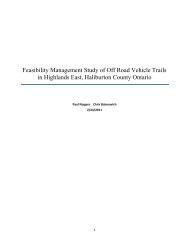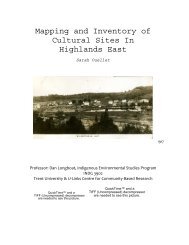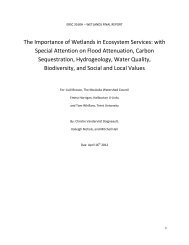Untitled - Haliburton County Community Cooperative Inc
Untitled - Haliburton County Community Cooperative Inc
Untitled - Haliburton County Community Cooperative Inc
- No tags were found...
You also want an ePaper? Increase the reach of your titles
YUMPU automatically turns print PDFs into web optimized ePapers that Google loves.
and their food and habitats are sensitive to high prevailing winds (Brown, 1998). Macrophytes as well astrees, shrubs and other shoreline vegetation provide exposure protection for many sensitive species,and their removal is determintal (Brown, 1998).Maintaining high diversity and abundance of fish species is important for ecosystem health andintegrity. This is essential to uphold to any community, not just the Muskoka Lakes region. Along withnatural prestige thou, maintaining fish diversity and abundance is an essential aspect of the economy ofthe Muskoka Lakes region. In 2005 fishing goods and services alone brought roughly $81.8 million tozone 15, the Muskoka Lake region. Any habitat lost attributed to shoreline development is detrimentalnot only to natural integrity of the region, but also its economy. Lake Joseph has shoreline developmentcoverage of 12%, Lake Rosseua 16%, and Lake Muskoka 17%, an average of 15% for the three majorlakes (Brown, 1998). Through research it conclusive that several major target species of the Muskokaregion rely on shoreline habitats for breeding and/or feeding, focusing on; walleye, northern pike,smallmouth bass, and largemouth bass. Taking the $81.1 million brought in by fishing in 2005, and thecatch percentage of these species for the same year, the following values can be produced for eachspecies; Walleye (rated number one targeted species for Muskoka anglers) bring in $4,055,000,Northern Pike $5,677,000, Smallmouth Bass $21,897,000, and Largemouth Bass $9,732,000, (grand totalof $41,361,000 from these species alone). If we assume that the average of 15% shoreline developmentof the three major lakes is applicable as an average to all lakes in the Muskoka Lakes region, we canproduce monetary values for these lost habitats. 15% habitat loss from shoreline development could beworth $6,204,150 lost from these four species alone. ($608,250 lost from lost walleye habitat, $850,050from lost pike habitat, $3,284,550 from lost smallmouth habitat, and $1,460,700 from lost largemouthhabitat). Each percent of habitat loss can result in $811,000 in lost revenue to the fishing industry.This Table from Browns research on Lake Joseph exemplifies typical development on lakes in theMuskoka District and how much land habitat they are taking up (Brown, 1998).27







